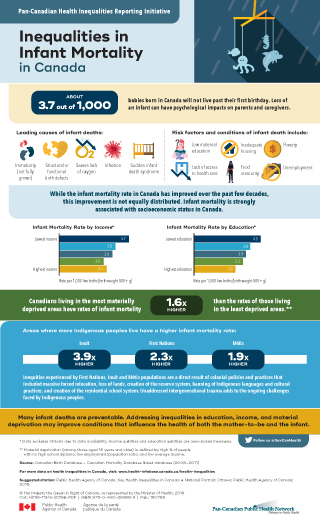Infographic: Inequalities in infant mortality in Canada

Download the alternative format
(PDF format, 775 KB, 1 page)
Organization: Public Health Agency of Canada
- Cat.: HP35-113/6-2019E-PDF
- ISBN: 978-0-660-29688-3
- Pub.: 180798
Pan-Canadian Health Inequalities Reporting Initiative
Inequalities in Infant Mortality in Canada
About 3.7 out of 1 000 babies born in Canada will not live past their first birthday. Loss of an infant can have psychological impacts on parents and caregivers.
Leading causes of infant deaths:
- Immaturity (not fully grown)
- Structural or functional birth defects
- Severe lack of oxygen
- Infection
- Sudden infant death syndrome
Risk factors of infant death include:
- Low maternal education
- Inadequate housing
- Lack of access to health care
- Food insecurity
- Poverty
- Unemployment
While the infant mortality rate in Canada has improved over the past few decades, this improvement is not equally distributed. Infant mortality is strongly associated with socioeconomic status in Canada:
| By income | Rate per 1 000 live births (birth weight 500+ g) |
|---|---|
| Lowest income | 4.7 |
| 3.8 | |
| 3.6 | |
| 3.0 | |
| Highest income | 3.2 |
| By education | Rate per 1 000 live births (birth weight 500+ g) |
|---|---|
| Lowest education | 4.5 |
| 3.8 | |
| 3.5 | |
| 3.3 | |
| Highest education | 2.8 |
Canadians living in the most materially deprived areas have rates of infant mortality 1.6 times higher than the rates of those living in the least deprived areas.Footnote **
Areas where more Indigenous peoples live have a higher infant mortality rate:
- Inuit
- 3.9 times higher
- First Nations
- 2.3 times higher
- Métis
- 1.9 times higher
Inequities experienced by First Nations, Inuit and Métis populations are a direct result of colonial policies and practices that included massive forced relocation, loss of lands, creation of the reserve system, banning of Indigenous languages and cultural practices, and creation of the residential school system. Unaddressed intergenerational trauma adds to the ongoing challenges faced by Indigenous peoples.
Many infant deaths are preventable. Addressing inequalities in education, income, and material deprivation may improve conditions that influence the health of both the mother-to-be and the infant.
Follow us @GovCanHealth
Source: Canadian Birth Database – Canadian Mortality Database linked database (2008-2011)
For more data on health inequalities in Canada, visit:
www.health-infobase.canada.ca/health-inequalities
Suggested citation: Public Health Agency of Canada. Key Health Inequalities in Canada: A National Portrait. Ottawa: Public Health Agency of Canada; 2018.
© Her Majesty the Queen in Right of Canada, as represented by the Minister of Health, 2019 | Cat.: HP35-113/6-2019E-PDF | ISBN: 978-0-660-29688-3 | Pub.: 180798